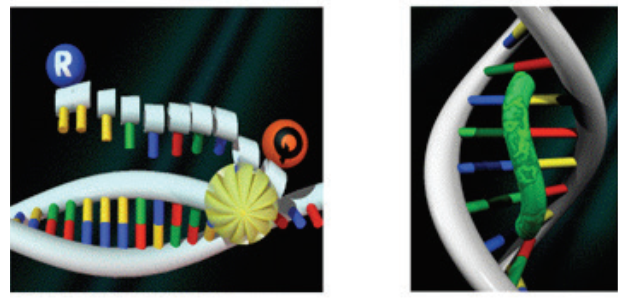- Restriction endonuclease: Restriction endonucleases are enzymes that cut nucleic acids (inclusive of DNA and RNA molecules) at specific sites. With restriction enzymes or endonucleases, molecular biologists can cut or nick DNA in a precise and reproducible manner which is crucial for gene cloning techniques and other molecular biology experimentation.
Restriction endonucleases are DNA cutting enzymes specifically found and isolated from bacteria; and which nick specific sites on a nucleotide sequence known as restriction sites. Restriction sites are the different sites on a DNA molecule that is nicked by a particular restriction enzyme. Several types of restriction enzymes exist, and they are primarily sourced from microorganisms (particularly bacteria) but they can also be chemically synthesized.
Restriction enzymes or endonucleases are usually divided into three (3) groups viz: Type I, Type II, and Type III restriction enzymes (REs). Type I and Type III REs bind to the nucleic acid molecule at their recognition sequences but they specifically nick the DNA molecule at a considerable distance away from the restriction sites. However, Type II REs are much more applicable for a variety of molecular biology manipulations because they cut DNA molecules at exactly their restriction sites.
Some examples of restriction enzymes are: EcoRI (from E. coli), HaeIII (from Haemophilus aegyptius), BamHI (from Bacillus amyloliquefaciens), PvuI (from Proteus vulgaris), HindII (from Haemophilus influenzae)and Sau3A (from S. aureus) amongst others. The nomenclature of restriction endonucleases is pretty simple. Restriction enzymes are generally named after the bacteria they were actually isolated from.
The first three alphabets in the name of a restriction enzyme represent the generic and species name of the bacteria while the remaining alphabets or numbers attached to the name represent the order of discovery of the enzymes in that particular organism. These later alphabets or numbers (usually in Roman numerals) may also represent the strain designate of the restriction endonucleases and the type.
For example, EcoRI is E. coli restriction enzyme I. Restriction endonucleases are applied in many molecular biology techniques including but not limited to gene cloning, gene amplification, DNA sequencing and in blotting techniques.
- Alkaline phosphatase: Alkaline phosphatase is an enzyme produced by organisms such as E. coli and the intestinal tissue of calf, and which removes the phosphate group that is present at the 5′ end of a DNA molecule. It specifically removes phosphate groups from the 5′ terminus of DNA to give the 5′-OH terminus that can join to the 3′ end of the vector that transports an exogenous DNA into a recipient host cell. Thus, preventing unwanted re-ligation or re-joining of already nicked or cut DNA molecules.
- DNA ligase: DNA ligase is an enzyme that specifically joins cut (nicked) DNA molecules together. They repair and join two individual single-stranded DNA fragments (i.e. the cloning vector and the DNA molecule to be cloned) cut by the same restriction endonuclease.
Ligation carried out by DNA ligase enzyme is usually the last step in the gene cloning technique prior to the transformation of the recipient bacterial cell. The joining of the DNA molecule to be cloned with the vector leads to the formation of a new molecule known as the recombinant DNA (rDNA) molecule.
Recombinant DNA molecule is a DNA molecule that is created by the ligation of a vector with a cut DNA molecule, and this normally occurs in a test tube where the cut DNA, vector and the DNA ligase enzymes are mixed together for the reaction to occur. In gene cloning technique for example, the same restriction enzyme used to cut the DNA of interest should be used to cut the vehicle or vector meant to carry the gene of interest into the recipient host cell.
Using the same restriction enzyme to do the nicking or cutting will ensure that one part is not abnormally cut, but are equally nicked so that they can be properly ligated or joined by the DNA ligase enzyme, which is mainly sourced from a genetically modified E. coli.
- Taq polymerase: Taq polymerase enzyme is a heat-stable DNA polymerase enzyme that is isolated from a thermostable bacteria (particularly Thermus aquaticus), and which is used in PCR techniques to extend primers along the single stranded DNA molecule in the 5′-3′ direction.
- DNA polymerase I: DNA polymerase I is an enzyme that synthesizes DNA molecules complementary to a DNA template in the 5′-3′ direction. It generally synthesizes DNA on a DNA or RNA template. The DNA polymerase I usually start from an oligonucleotide primer with a 3′ OH terminus and it is used to extend the oligonucleotide primers along the single stranded DNA molecules. DNA polymerases are synthesized by E. coli, and they perform similar activity like the Taq polymerase enzyme. They base-pair and polymerizes the growing DNA strands until the termination site is reached.
- RNase enzyme: RNase enzyme is a nuclease enzyme which digests RNA.
- DNase enzyme: DNase enzyme is a nuclease enzyme which digests DNA.
- Nucleases: Nucleases are degradative enzymes that cut, shorten and degrade nucleic acids (inclusive of DNA and RNA). They are usually used in PCR reaction and other molecular biology experimentations to digest nucleic acid molecules.
References
Alberts B, Bray D, Lewis J, Raff M, Roberts K and Watson J.D (2002). The molecular Biology of the Cell. Fourth edition. New York, Garland, USA.
Chen I and Dubnau D (2004). DNA uptake during bacterial transformation. Nat. Rev. Microbiol. 2 (3): 241–249.
Cooper G.M and Hausman R.E (2004). The cell: A Molecular Approach. Third edition. ASM Press.
Dale J (2003). Molecular genetics of bacteria. Jeremy W. Dale and Simon Park (4th eds.). John Wiley & Sons Ltd, West Sussex, UK. Pp. 312-313.
Das H.K (2010). Textbook of Biotechnology. Fourth edition. Wiley edition. Wiley India Pvt, Ltd, New Delhi, India.
Lewis R (2004). Human Genetics: Concepts and Applications. Sixth edition. McGraw Hill Publishers, USA.
Lodish H, Berk A, Matsudaira P, Kaiser C.A, Kreiger M, Scott M.P, Zipursky S.L and Darnell J (2004). Molecular Cell Biology. Fifth edition. Scientific American Books, Freeman, New York, USA.
Madigan M.T., Martinko J.M., Dunlap P.V and Clark D.P (2009). Brock Biology of Microorganisms, 12th edition. Pearson Benjamin Cummings Inc, USA.
McPherson M and Moller S (2002). PCR: The Basics. 2nd edition. Taylor and Francis Group. New York, USA.
Sambrook, J., Russell, D.W. (2001). Molecular Cloning: a Laboratory Manual, 3rd edn. Cold Spring Harbor Laboratory Press, New York.
Synder L, Peters J.E, Henkin T.M and Champness W (2013). Molecular Genetics of Bacteria. Fourth edition. American Society of Microbiology Press, USA.
Tamarin Robert H (2002). Principles of Genetics. Seventh edition. Tata McGraw-Hill Publishing Co Ltd, Delhi.
Discover more from Microbiology Class
Subscribe to get the latest posts sent to your email.





